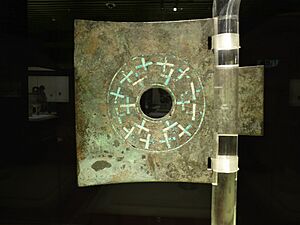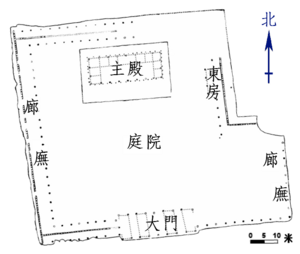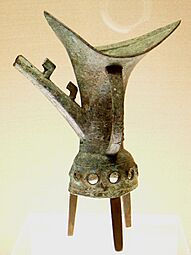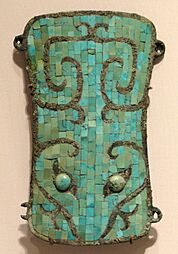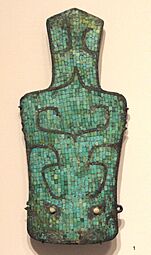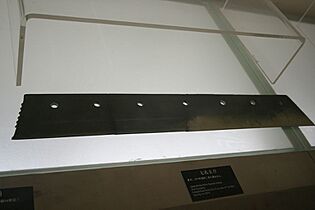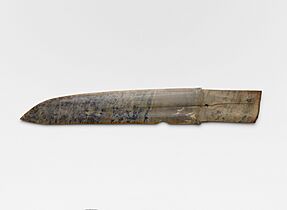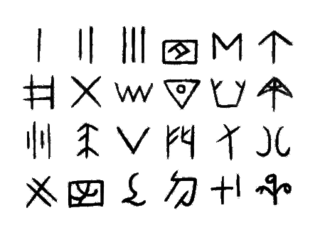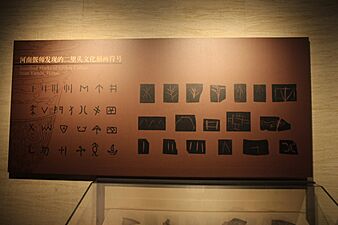Erlitou culture facts for kids
The Erlitou culture was an ancient society that lived in China during the Bronze Age, roughly from 1900 to 1500 BC. It was located in the Yellow River valley, mainly in what is now Henan and Shanxi provinces. Many experts believe the Erlitou culture was the first true "state" in China. This means it was a complex society with organized government, large cities, and specialized workers. Chinese archaeologists often connect the Erlitou culture with the legendary Xia dynasty, but there's no clear written proof like the later Chinese characters to confirm this link.
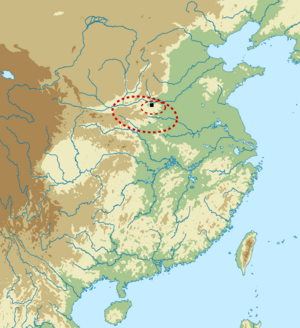
Erlitou in eastern China
|
|||||||
| Geographical range | Western Henan | ||||||
|---|---|---|---|---|---|---|---|
| Period | Bronze Age China | ||||||
| Dates | c. 1900–1500 BC | ||||||
| Type site | Erlitou | ||||||
| Preceded by | Longshan culture | ||||||
| Followed by | Erligang culture | ||||||
| Defined by | Xu Xusheng | ||||||
| Chinese name | |||||||
| Traditional Chinese | 二里頭文化 | ||||||
| Simplified Chinese | 二里头文化 | ||||||
|
|||||||
Contents
Discovering the Erlitou Site
The main Erlitou site was found in 1959 by a researcher named Xu Xusheng. It's the biggest and most important place connected to this ancient culture. The site is located near the Yi River, which flows into the Yellow River.
Archaeologists have found large palace buildings and workshops where people made bronze objects. The Erlitou people were very skilled at making ritual bronze vessels, which are special containers used in ceremonies. They were the first to make many of these items, like the earliest ding vessels (a type of ancient cauldron).
Today, you can visit the Erlitou Relic Museum in Luoyang, Henan province. It opened in 2019 and displays over 2,000 items found at the Erlitou site.
How the City Grew: Four Phases
The Erlitou site grew and changed over four main periods, or phases:
Phase I: A Growing Center
In its first phase, Erlitou was a quickly growing regional center. It covered about 100 hectares (about 250 acres). Thousands of people lived there, but it wasn't yet a fully developed city.
Phase II: Becoming a City
During Phase II, Erlitou started to become a true urban center. It expanded to about 300 hectares (about 740 acres) and had a population of around 11,000 people. A special area for palaces was built, surrounded by four roads. This area included large buildings like Palace 3 and Palace 5. A bronze workshop was also set up, controlled by the city's leaders.
Phase III: The City's Peak
Erlitou reached its largest size and population in Phase III, with about 24,000 people. The palace complex was protected by a thick wall made of packed earth. More palaces, like Palace 1 (the biggest one), Palace 7, Palace 8, and Palace 9, were built. Some older palaces were replaced by new ones.
Phase IV: Decline and Change
In Phase IV, the population of Erlitou began to decrease to about 20,000. However, new buildings like Palace 6, Palace 10, and Palace 11 were still constructed. Around 1600 BC, a new walled city was built nearby at Yanshi.
Eventually, the production of bronzes and other special goods stopped at Erlitou. This happened around the same time that the Erligang city of Zhengzhou became important, about 85 kilometers (53 miles) to the east. There's no sign of a war or fire destroying Erlitou. Instead, it slowly became a smaller village.
Amazing Bronze Work
The Erlitou culture was the first in China to produce bronze items on a large scale. They used a special method called the "section-mold process" to create ritual vessels and other bronze objects.
While some bronze pieces have been found in other cultures, Erlitou bronzes were much more advanced and common. The Erlitou people made many different kinds of bronze items, including tools, musical bells, weapons, and unique plaques shaped like animal faces. They even created more than ten different types of bronze vessels. This shows how skilled and organized their bronze casting was.
Many of the bronze items from Erlitou looked like pottery, with smooth surfaces or simple geometric patterns. Some bronze jue (goblets) from the third phase even had decorative holes.
Some of the earliest examples of famous Chinese artifacts were found at Erlitou sites. The first bronze ding (cauldrons) in China, decorated with striped patterns, were found here. The earliest metal bells, dating back to about 2000 BC, were also discovered at Erlitou and a nearby site called Taosi. The first bronze dagger-axes, called ge, were found at Erlitou as well.
Beautiful Jade Objects
Just like other cultures in China at the time, the Erlitou people also worked with jade. They shaped jade into special objects used for rituals and ceremonies. These included ceremonial blades called zhang and ritual dagger-axes known as ge.
Mysterious Symbols
Archaeologists have found symbols on ceramic pieces from Erlitou sites. These symbols have made some people wonder if they are connected to the very first Chinese characters, which appeared a few centuries later in the same area. However, there's no clear proof yet. For now, these symbols are thought to be markings or a very early form of writing, sometimes called proto-writing.
Erlitou and Ancient Chinese Stories
One big goal for archaeologists in China is to find the actual capital cities of the ancient Xia dynasty and Shang dynasty. These dynasties are described in old Chinese stories, like the Bamboo Annals and the Records of the Grand Historian. However, these stories were written much later, so historians debate how accurate they are, especially about the Xia dynasty.
When Xu Xusheng first found Erlitou, he thought it might be Bo, the first capital of the Shang dynasty. Since the late 1970s, many Chinese archaeologists have suggested that Erlitou was actually Zhenxun, the last capital of the Xia dynasty.
The story of the Shang dynasty overthrowing the Xia dynasty is a famous one. Some scholars believe that the end of each of Erlitou's four phases might relate to this event. The Xia–Shang–Zhou Chronology Project identified all four phases of Erlitou as belonging to the Xia dynasty. They believe the building of the walled city at Yanshi marked the beginning of the Shang dynasty. However, scholars outside China often point out that there's no solid proof to link Erlitou directly to the Xia dynasty.
Some researchers have also suggested that a huge flood that happened around 1920 BC might be connected to the ancient myths about a great flood in China. This flood happened just before the Erlitou culture became powerful. They argue this timing could support the idea that the Xia dynasty was indeed the Erlitou culture. However, no evidence of widespread flooding in the North China Plain at that time has been found yet.
See also
- List of Neolithic cultures of China
- Three Sovereigns and Five Emperors


